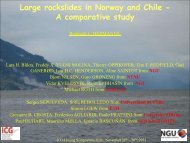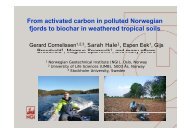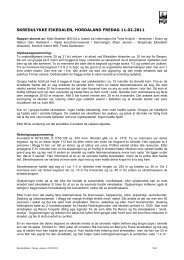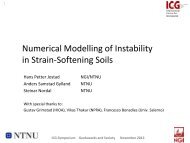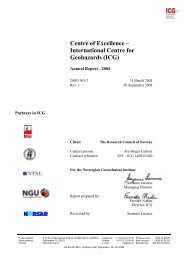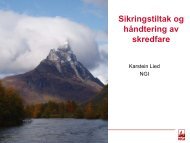Biochar in Indonesia, Malaysia, Nepal, Zambia, Tanzania - 5 ... - NGI
Biochar in Indonesia, Malaysia, Nepal, Zambia, Tanzania - 5 ... - NGI
Biochar in Indonesia, Malaysia, Nepal, Zambia, Tanzania - 5 ... - NGI
You also want an ePaper? Increase the reach of your titles
YUMPU automatically turns print PDFs into web optimized ePapers that Google loves.
<strong>Biochar</strong> <strong>in</strong> <strong>Indonesia</strong>, <strong>Malaysia</strong>, <strong>Nepal</strong>, <strong>Zambia</strong>, <strong>Tanzania</strong> -<br />
5 projects at Norwegian Geotechnical Institute and<br />
Norwegian University of Life Sciences<br />
Comb<strong>in</strong>ation soil science, socio-economic science, implementation<br />
– Norwegian Embassy – <strong>Zambia</strong>, 2010-2015<br />
– Nordic Climate Fund – <strong>Tanzania</strong>, 2013-2015<br />
– Norwegian Research Council –<br />
• ”NorGlobal”, ”FRIMUF”, <strong>Indonesia</strong> + <strong>Malaysia</strong>, 2011-2014<br />
• ”Young Investigator Personal Grant”, <strong>Zambia</strong>/<strong>Nepal</strong>/<strong>Indonesia</strong>, 2012-2017<br />
Kaoma,<br />
<strong>Zambia</strong><br />
<strong>Indonesia</strong> <strong>Malaysia</strong> Norway<br />
biochar consortium
Several “w<strong>in</strong>s” with biochar<br />
Climate change mitigation<br />
• Carbon storage<br />
• Reduces other greenhouse gas emissions:<br />
nitrous oxide (N 2 O), methane (CH 4 )<br />
2 4<br />
Soil fertility improvement<br />
B<strong>in</strong>d<strong>in</strong>g soil contam<strong>in</strong>ants
Field Sites <strong>Zambia</strong><br />
18 maize<br />
farmers<br />
Mkushi<br />
Kaoma<br />
Mongu<br />
(2012)<br />
NRDC<br />
Chisamba<br />
UNZA farm<br />
Shimabala
Biokull and conservation farm<strong>in</strong>g: <strong>Zambia</strong><br />
Conservation Tillage: plant<strong>in</strong>g bas<strong>in</strong>s, only 10-12% tilled<br />
Strongly reduces amount of biochar (and fertilizer) needed<br />
Maize cob<br />
biochar
Kaoma, Western <strong>Zambia</strong><br />
Look<br />
<strong>Biochar</strong><br />
Works<br />
<strong>in</strong> poor, sandy soil<br />
at low nutrient status<br />
and low water hold<strong>in</strong>g capacity<br />
2012:<br />
<strong>Biochar</strong> strongly positive effect for 14<br />
out of 18 farmers on sandy soil:<br />
6 ton/ha 281 ± 153% of control<br />
2 ton/ha 178 ± 99% of control charcoal<br />
4 t/ha<br />
control<br />
maize char<br />
4 t/ha
Block trial, acidic oxisol:<br />
clear effect of 6 tons/ha biochar<br />
maize char<br />
0 t/ha<br />
maize char<br />
6 t/ha
NRDC: good soil<br />
(not acidic, good CEC and water hold<strong>in</strong>g capacity)<br />
No effect of biochar<br />
Control Wood Char 4 t/ha Maize Char 4t/h<br />
t/ha<br />
Cornelissen, G; et al. Agronomy, 2013.
Why is biochar so effective<br />
• Compensation of acidity<br />
• Nutrient sponge<br />
• Water sponge<br />
NH + No effect <strong>in</strong><br />
4 sorption isotherm<br />
field<br />
Soil/<br />
Soil/ char<br />
CEC pH, no biochar CEC + pH, 5% biochar<br />
char Al availability (cmol/kg) Al availability 5% biochar<br />
Soil Good<br />
(cmol ch/kg)<br />
+ 5% biochar<br />
effect Mkushi<br />
Mkushi<br />
<strong>in</strong> soil<br />
3<br />
49 4.9 8<br />
68 6.8<br />
field Kaoma<br />
Kaoma soil New 4 7<br />
5.4 7.0<br />
UNZA station 9 11<br />
Mkushi UNZA soil 0.18 3.8 < 0.01<br />
6.2<br />
2012<br />
Kaoma Charcoal dust 0.02 < 0.01<br />
Charcoal dust biochar 85<br />
biochar<br />
8.8<br />
UNZA 1.14 0.02<br />
Corn cob biochar 40 87 8.7<br />
K d = 100 L/kg<br />
Cornelissen, G; et al. Agronomy, 2013.<br />
Hale, S.E.; et al. Chemosphere, 2013.
Pot trial <strong>Zambia</strong> (4 soils, 2 biochars, 128 pots)<br />
1. 0.5% biochar + full fertilizer 43 gbiomass<br />
2. 2% biochar + 50% of fertilizer 34 g biomass<br />
3. Only fertilizer 27 gbiomass<br />
4. Only 2% biochar 12 g biomass<br />
5. Control 5 gbiomass<br />
Control NPK Maize C Char C<br />
+½NPK<br />
Maize C<br />
+½NPK
Challenges for biochar implementation <strong>in</strong> <strong>Zambia</strong><br />
• Corn cobs not enough feedstock: use stems, pigeon peas,<br />
legum<strong>in</strong>ous trees<br />
• <strong>Biochar</strong> generation technology: stoves too small, retort kilns<br />
too expensive, traditional kilns too dirty<br />
Improved cook<strong>in</strong>g<br />
stoves<br />
Clean retort kiln<br />
Traditional brick kiln
Full Life-cycle assessment biochar <strong>in</strong> <strong>Zambia</strong><br />
Nor rmalized impact<br />
(ecopo<strong>in</strong>ts)<br />
250<br />
Conventional agriculture<br />
Conservation farm<strong>in</strong>g<br />
200<br />
CF ‐ trad kiln<br />
CF ‐ retort kiln<br />
150<br />
CF ‐ TLUD<br />
100<br />
50<br />
0<br />
Kaoma‐ strong yield effect of biochar<br />
‐50<br />
Climate Change<br />
impacts<br />
Particulate<br />
Matter emission<br />
M<strong>in</strong>eral and<br />
fossil fuels<br />
Rema<strong>in</strong><strong>in</strong>g<br />
categories<br />
Overall impact<br />
Normaliz zed impact (eco opo<strong>in</strong>ts)<br />
160<br />
140<br />
120<br />
100<br />
80<br />
60<br />
40<br />
20<br />
0<br />
Conventional agriculture<br />
Conservation farm<strong>in</strong>g<br />
CF ‐ trad kiln<br />
CF ‐ retort kiln<br />
CF ‐ TLUD<br />
UNZA ‐ moderate yield effect of biochar<br />
‐20<br />
Climate Change Particulate M<strong>in</strong>eral and Rema<strong>in</strong><strong>in</strong>g Overall impact<br />
impacts Matter emission fossil fuels categories<br />
Sparrevik, M.; et al. Environ. Sci. Technol. 2013.
Kalikhastan<br />
Bhaktapur<br />
Dhad<strong>in</strong>g
Field trials, Dhad<strong>in</strong>g, acid C-poor soil<br />
Feedstock Eupatorium<br />
Feedstock Eupatorium,<br />
”Forest Killer”
Dhad<strong>in</strong>g, <strong>Nepal</strong><br />
Increased harvest with <strong>in</strong>creas<strong>in</strong>g biochar amount
Sigi, Lore L<strong>in</strong>du NP<br />
Lampung<br />
Bogor<br />
Central<br />
Kalimantan<br />
NTT, West Timor
Chemical screen<strong>in</strong>g<br />
Chemical pH screen<strong>in</strong>g of acid soil-biochar comb<strong>in</strong>ations<br />
<strong>Biochar</strong>s<br />
Oil Palm Shell<br />
Rice Husk<br />
Cacao Shell
Chemical screen<strong>in</strong>g: addition of biochar to soil<br />
30 soils tested for the pH effect of biochar addition (3 chars, 7 dosages)<br />
Cacao shell biochar<br />
Rice husk biochar<br />
Mart<strong>in</strong>sen, V.; et al. Plant and Soil. 2013.
Lampung, Sumatra, field test after 2 weeks:<br />
Lampung, Sumatra, field test after 2 weeks:<br />
wet rice, dry rice, maize; cacao and rice husk char
Lampung, <strong>Indonesia</strong>. Sandy loam, pH: 4,1<br />
Cacao shell biochar also better than rice husk biochar <strong>in</strong> the field<br />
0 ton/ha 5 ton/ha 15 ton/ha
West Timor; Farmer engagement<br />
g
West-Timor; Corn trial; 30% better harvest for<br />
heavy clay pH 7: improved dra<strong>in</strong>age
Thank you for<br />
your<br />
attention!<br />
White<br />
Is<br />
Wonderful....<br />
But Black<br />
is Best!!!!





